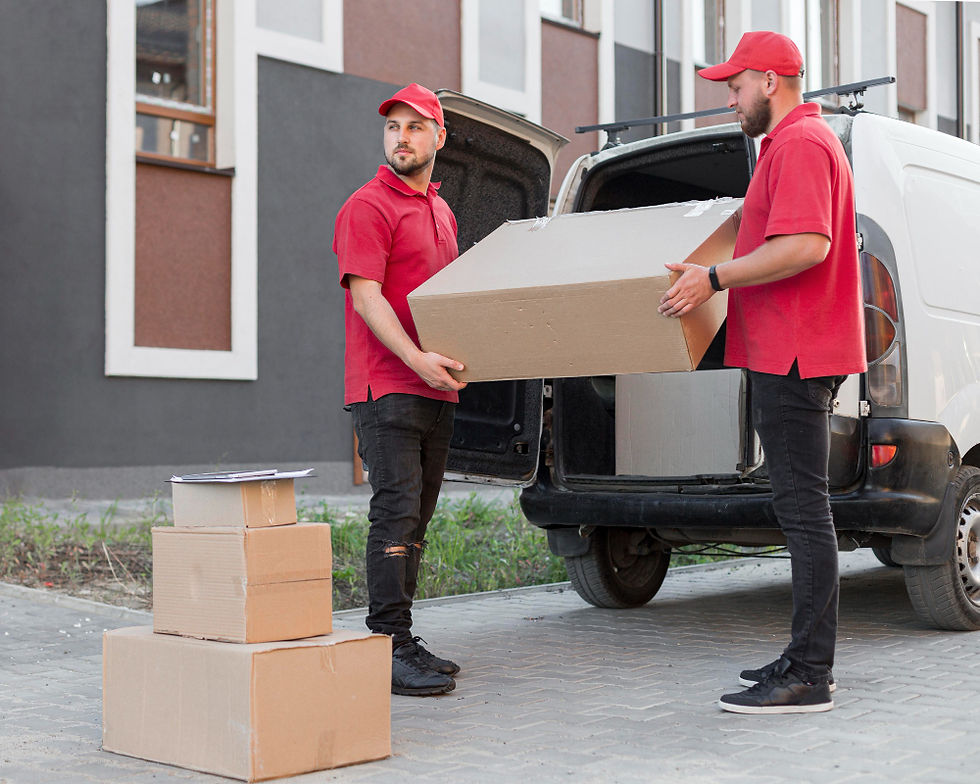The Ultimate House Shifting Checklist: Your Stress-Free Guide to a Smooth Move
- Stephen Patrick

- Aug 22
- 10 min read
Updated: Aug 22
Starting over in a new home is exciting. You get the chance to create new routines, explore a different neighborhood, and make fresh memories. But right alongside that excitement of house shifts is the reality: moving is a huge job. It's not just about tossing things into boxes. It's about sorting through years of belongings, figuring out what to keep or donate, scheduling movers, updating paperwork, and making sure nothing slips through the cracks. Before long, the excitement can get buried under stress and exhaustion.
Here's the thing: moving doesn't have to feel like an uphill battle. The difference between a chaotic move and a smooth one usually comes down to one word: organization. When you have a clear house shifting checklist, all those scattered tasks stop feeling so overwhelming. Instead of scrambling at the last minute or second-guessing yourself, you know exactly what needs to be done and when to do it.
That's where this guide comes in. Think of it as your roadmap for moving. We'll walk through the entire process step by step, starting months before moving day and carrying you through your final walkthrough. Each stage is broken down into manageable pieces so you can keep your move on track without losing your mind. By the end, you won't just be moving, you'll be settling in with confidence, ready to enjoy your new space.
8 Weeks Before the Move: Planning & Preparation
The key to a smooth move is starting early. The more you can plan and prepare in the beginning, the less stress you'll have in the final, frantic weeks.

Set the Dates
First things first: finalize your moving date. If you're moving a long distance, a specific date is crucial. If you're moving locally, you might have more flexibility, but having a solid date in mind will help you plan everything else. Consider avoiding peak moving seasons (like summer) or the end of the month, as these times are often more expensive and more complicated to book movers.
Create a Budget
Moving costs more than you think. Start by creating a budget to estimate expenses for movers, packing of supplies, new furniture, and any services you might need. Don't forget to account for small costs in your relocation checklist, like food during the move, cleaning supplies, and utility deposits for your new home. A clear budget will prevent financial surprises down the road.
Research and Book Movers
This is one of the most critical tasks. Start researching moving companies at least two months in advance, especially if you're moving a long distance. Get quotes from at least three different companies. Be sure to read reviews, check for proper licensing and insurance, and ask for a detailed, written estimate. Once you've chosen a company, book them as soon as possible to lock in your date and price.
Declutter and Downsize
This is a huge and often overlooked part of the moving process. The more you get rid of, the less you have to pack, move, and unpack. Start with one room at a time and go through everything. Create three piles: "Keep," "Donate/Sell," and "Trash." Be ruthless! Getting rid of unused clothes, old furniture, and broken items now will save you a ton of time and money later.
Create a Master Folder
Moving involves a lot of paperwork. Start a master folder, either physical or digital, to keep all your moving-related documents in one place. This should include your moving company contract, insurance information, utility contact numbers, and any other important receipts. Having everything in one spot will save you from scrambling for information later on.
Take Inventory of Valuables
Before you start packing, take photos and create a list of all your high-value items, such as expensive electronics, jewelry, or artwork. This will serve as a record in case anything is damaged or lost during the move. For very valuable or sentimental items, consider moving them yourself.
Measure Your New Home
Get a floor plan or a simple sketch of your new home. Measure the rooms and major doorways. This will help you plan where your existing furniture will go and prevent you from moving a sofa that won't fit through the door. This little bit of planning can save a lot of headaches on moving day.
4-6 Weeks Before the Move: Getting Serious
With two months of prep behind you, it's time to start tackling the more hands-on tasks in your new house moving checklist that will set you up for a smooth final month.

Order Packing Supplies
Don't wait until the last minute to get your packing materials. Make a list of everything you'll need and order it early. This includes a variety of box sizes, packing tape, bubble wrap, wrapping paper, permanent markers, and box cutters. Buying these in bulk can often be more cost-effective.
Start Packing (Non-Essentials)
Now is the time to start packing items you won't need for the next month or two. This is a great way to ease into the packing process. Start with the garage, basement, or any storage areas. Pack up off-season clothes, books you've already read, and decorative items. Label each box clearly with its contents and the room it's going to. This simple step in your house move checklist will make unpacking a thousand times easier.
Notify Key Contacts
Start informing people and organizations of your move. This includes your children's schools, your doctors, dentists, and other healthcare providers. You may also need to request new records be sent to your new providers. This is a good time to research new doctors and schools in your new neighborhood.
Update Address and Mail Forwarding
Visit your local post office or go online to set up mail forwarding. This will ensure that all your mail is sent to your new address, and it's a great way to catch any contacts you may have forgotten to inform. You should also start updating your address on magazines, subscriptions, and other services.
Plan for Utilities
Make a list of all your current utilities—electricity, water, gas, internet, and cable. Call them to schedule a disconnect date for your current home. Then, call the utility companies in your new location to schedule a connect date. Try to have the utilities turned on a day before you move in, if possible, so you have power and water from day one.
Plan for Kids and Pets
Moving can be very stressful for children and pets. Arrange for a trusted friend, family member, or babysitter to look after your kids on moving day. The same goes for your pets. Having them in a safe, quiet place will give you one less thing to worry about. Make sure you have all their food, toys, and supplies packed in a separate, easily accessible bag.
2-3 Weeks Before the Move: The Final Push
The countdown is on, and it's time to tackle the more hands-on tasks in your moving house checklist. This is where you focus on packing up your daily life and making sure all the logistical details are set.

Pack Everything Else
By now, the majority of your non-essential items should be packed. Start packing up the rest of your home, saving only the items you'll need for the final week. Label each box clearly with both a general description of its contents (e.g., "Kitchen - Pots and Pans") and the room it belongs in at your new home. This is crucial for an organized and efficient unpacking process.
Your Room-by-Room Essentials Box
Your essentials box is arguably the most crucial box you will pack for a house shift. This house shifting checklist should contain everything you need to be comfortable and functional from the moment you arrive, so you don't have to hunt through dozens of boxes. Consider packing a separate essentials box for each key room to make things even easier.
Kitchen Essentials: A box with a few mugs, a coffee maker or kettle, paper towels, dish soap, a sponge, a set of basic utensils, a can opener, and some easy-to-prepare snacks will make a world of difference.
Bedroom Essentials: Pack bedding, pillows, and a change of clothes for each family member. An alarm clock and a power strip can be a lifesaver for charging multiple devices.
Closet Essentials: A few key outfits for work and daily life, as well as an empty laundry bag or hamper to contain clothes that need to be washed. A few uniform hangers and shoe organizers can help you get your closet started and keep things tidy from day one. Don't forget to pack Roomedys® Spacing Tape for Hangers (RST) with you. A quick setup by sticking it to your hanging rod lets you lay out your clothes in a way that's perfect for work, home, and kids. It gives you perfectly even spacing between hangers, so your clothes stay in place, nothing gets lost in the shuffle, and your closet always looks organized. Just stick it to your closet rod; no tools are needed. You can adjust the spacing for single, double, or triple-width gaps, and it works for both adult and kid closets. This small change has a big impact, and you do it once and it's done.
Bathroom Essentials: Pack a roll of toilet paper, hand soap, one towel for each family member, medications, and a first aid kit in a dedicated bathroom box. Don't forget a shower curtain if your new home doesn't have one.
Cleaning & Tool Essentials: A box with an all-purpose cleaner, sponges, paper towels, a box cutter, scissors, a roll of tape, and a flashlight will help you wipe down surfaces, open boxes, and keep your new space tidy as you unpack.
Important Documents & Valuables: Keep a separate, secure box or bag with all your important documents, like passports, birth certificates, and financial paperwork. This box should stay with you at all times and not go on the moving truck.
Confirm with Movers
Call your moving company to reconfirm all the details: the date, time, address, and any special instructions you might have. Ask for their contact information for moving day. This will prevent any last-minute mix-ups and give you peace of mind.
Clean Out the Pantry
Start using up perishable food. Plan simple meals for the final week that use up items in your fridge, freezer, and pantry. This will reduce waste and the amount of food you have to move.
Return Borrowed Items
Take a moment to return any items you've borrowed from friends, family, or the library. This is a simple but important step to tie up loose ends before you leave.
Prepare Appliances
If you're taking your appliances with you, make sure they are ready to go. Defrost and clean the fridge and freezer. Empty and clean the washer and dryer. Check with your moving company for any specific instructions on preparing appliances for transport.
The Final Week: The Countdown
You are in the home stretch! This final week is about last-minute details in your house move checklist and getting everything ready for the big day.

Finish Packing
Based on your house shifting checklist, all of your packing should be completed by now, with the exception of a small overnight bag that contains your essentials for the first night at your new home.
Final Utilities Check
Double-check that all your utilities are scheduled to be turned off at your old home on the correct day and turned on at your new home. This is a small detail that can make a big difference.
Final Cleaning
Deep clean your old home, or book a cleaning service to do it for you. This is an important step, especially if you are renting, as it will help you get your security deposit back.
Take Photos and Videos
If you are renting, take photos and videos of the entire home before you leave. This will serve as a record of the home's condition and help you avoid any disputes with your landlord.
Empty Trash and Do a Walkthrough
Do a final sweep of every room for any last-minute garbage. Do a final walkthrough of the entire house to ensure nothing is left behind. Check all the cabinets, drawers, closets, and even the attic or basement.
Prepare Payments
Have cash or payment ready for the movers on moving day. Be prepared to tip them for a job well done.
Moving Day & Beyond: The New Beginning
The day is finally here! This final section is about making sure the moving day goes smoothly and that you are prepared to start your new life in your new home.

Supervise the Movers
Be present to direct the movers. Point out the boxes that need to be handled with care and show them where you want the furniture to go.
Final Meter Readings
Take photos of the gas, water, and electricity meters in your old home. This will serve as a record of your final usage and prevent any disputes with the utility companies.
Final Walkthrough (Again!)
Once the movers have left your old home, do a final walkthrough of every room to ensure nothing is left behind.
Arrive at the New Home
Once you arrive at your new home, do a quick inspection before the movers start unloading. Check for any damage or issues that may need to be addressed.
Unpack the Essentials Box
Get the essentials box out immediately. This will allow you to get the necessities out of the way and have what you need to make the first night more comfortable.
Set Up a Bed
Make at least one bed for a good night's sleep. This is a small but important step that will make a huge difference after a long day of moving.
Check Utilities
Double-check that the water, power, and heat are working in your new home. This will allow you to get settled in and start enjoying your new space.
Unpack Systematically
Don't try to unpack everything at once. Start with the kitchen and bedrooms. Unpack the most important items first and work your way to the less important ones.
Update Address (Again) and Explore
Don't forget to notify your bank, insurance companies, and other services of your new address. Take a walk around your new neighborhood, find local spots, and start settling in. Congratulations, you've made it!
Conclusion
A successful move is built on a solid plan. A comprehensive house shifting checklist is an essential tool for navigating the numerous tasks involved, from initial decluttering to final unpacking. By dedicating time to preparation and organization, you can significantly reduce the stress associated with moving. With every detail accounted for, the transition into your new home becomes a more efficient and positive experience, allowing you to settle in with ease.
More From Roomedys:
Author: Stephen Patrick

Stephen is the Founder and CEO of the Roomedys® brand. Stephen’s inaugural, multi-patented invention, Roomedys® Spacing Tape for Hangers (RST), is poised to transform the world of closet organization. Having spent 25 years in the hospitality industry, Stephen is an expert in functional organization. His mantra, “Everything has a place; everything stays in place,” is the key to achieving a realistic & maintainable routine that provides a feeling of balance and well-being.



Comments